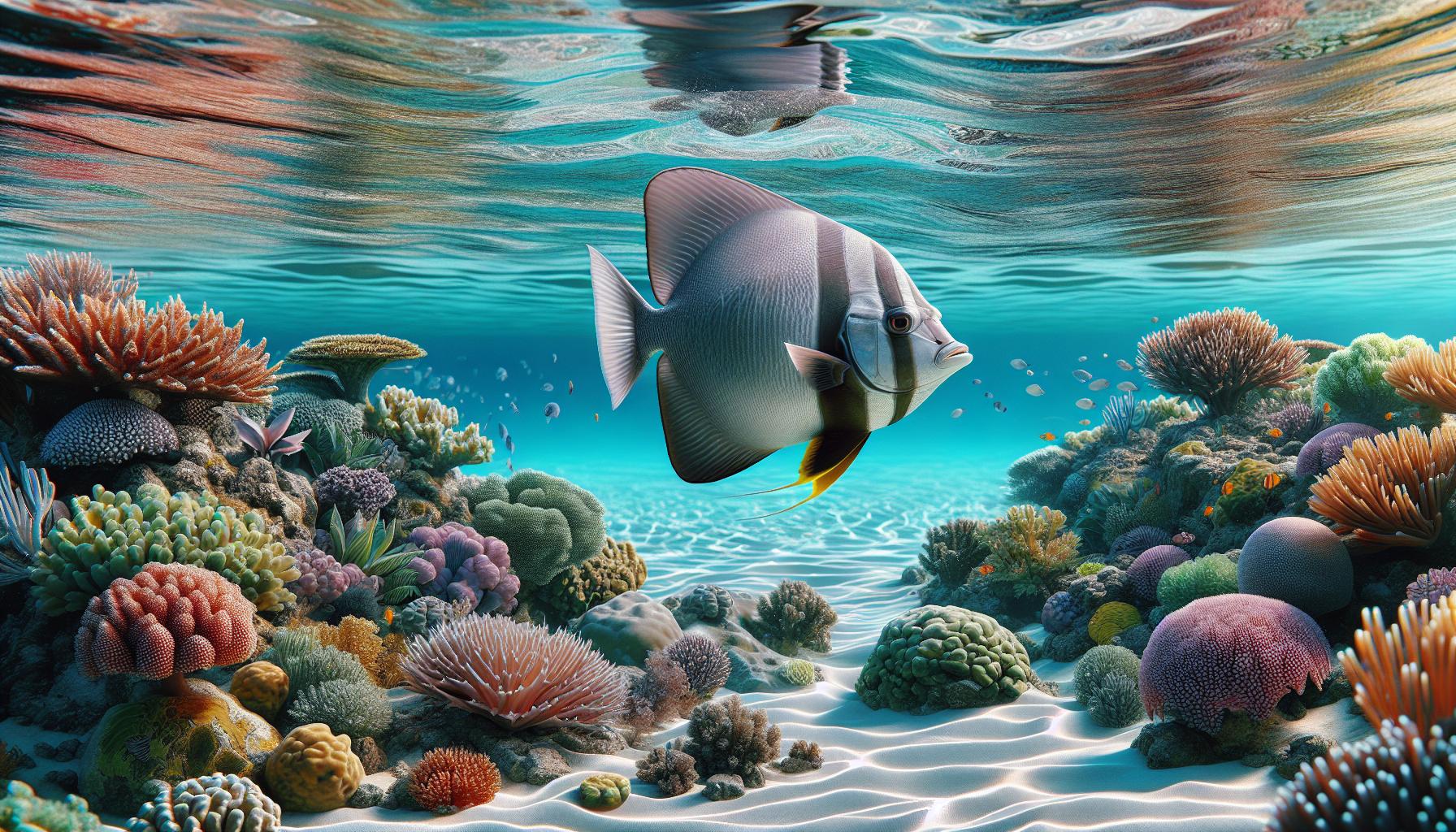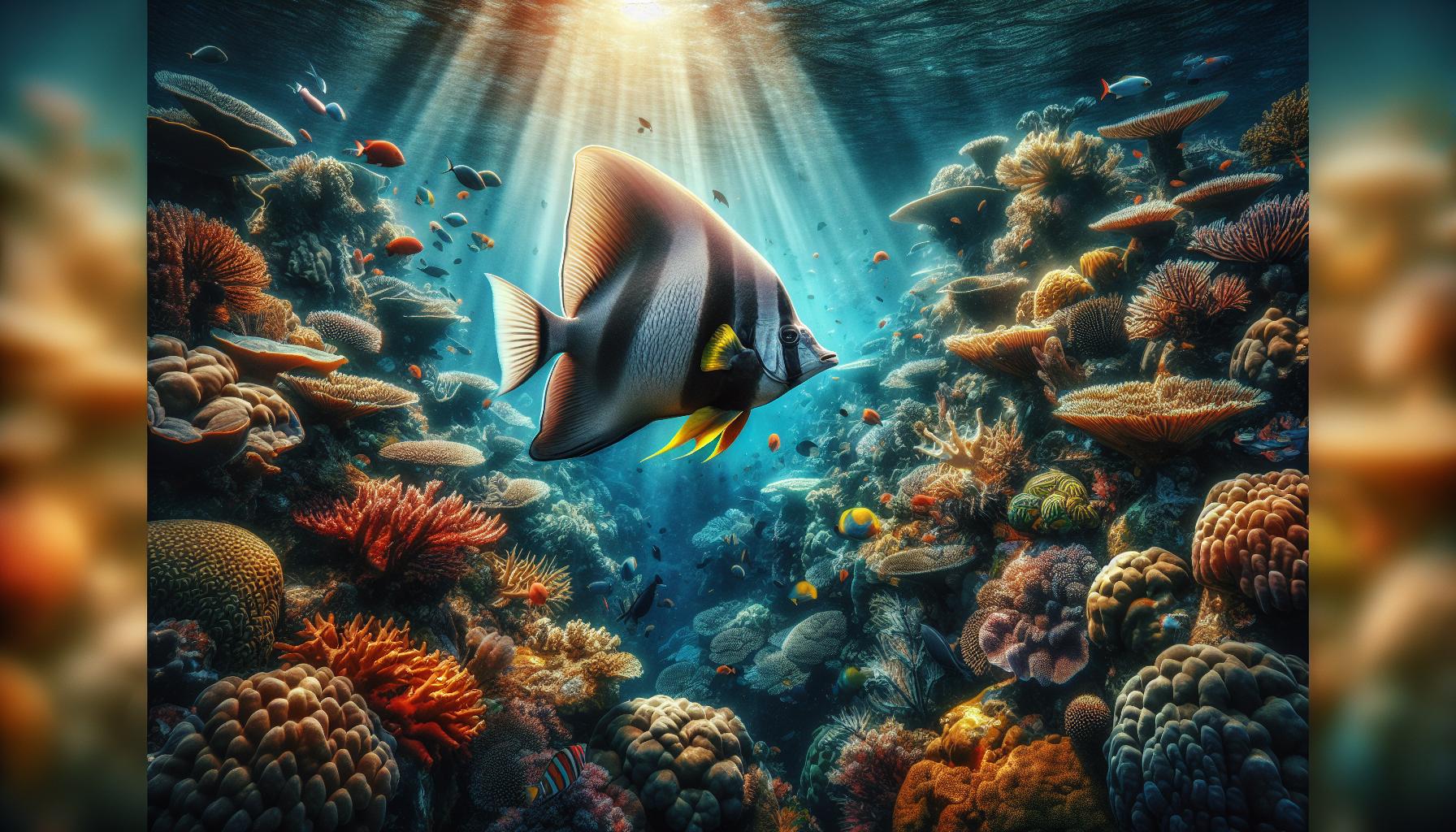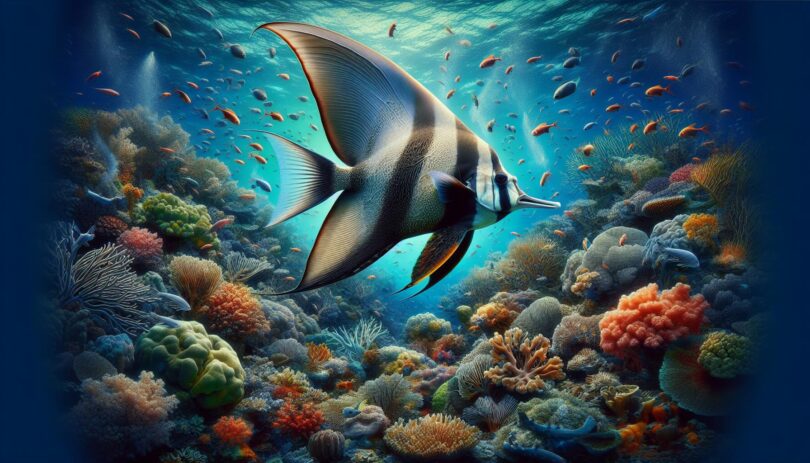Pinnatus Batfish, often hailed as the ocean’s winged beauties, have always captivated my imagination. Their unique appearance, with fins that resemble the wings of a bat, sets them apart in the marine world. Diving into their habitat, we find these creatures in the shallow waters of the Indo-Pacific, painting the seascape with their striking black bodies and vibrant orange outlines.
Exploring the world of Pinnatus Batfish is like uncovering a hidden gem of the ocean. Their mysterious nature and graceful swimming patterns make them a fascinating subject for marine enthusiasts and aquarium hobbyists alike. Let’s dive deeper into understanding these magnificent creatures and what makes them so special.
Key Takeaways
- Pinnatus Batfish, known for their distinctive bat-like fins and striking black bodies with vibrant orange outlines, are native to the warm, shallow waters of the Indo-Pacific, thriving in coral reefs and lagoons.
- Their unique physical characteristics, including elongated dorsal and anal fins and a deep black body with bright borders, serve as both a camouflage mechanism against predators and a testament to their agility and adaptability in the marine environment.
- The diet of Pinnatus Batfish evolves from small invertebrates and zooplankton in their juvenile stage to algae and detritus in adulthood, underscoring their adaptability and crucial role in maintaining the health and balance of coral reef ecosystems.
- Pinnatus Batfish exhibit interesting social behaviors and swimming patterns, forming small groups during their juvenile phase for protection and developing efficient foraging strategies that leverage their unique physique.
- The conservation status of Pinnatus Batfish is concerning, with their habitats facing threats from climate change, pollution, and overfishing, highlighting the importance of marine conservation areas and sustainable practices in the aquarium trade to protect these and other marine species.
Habitat of Pinnatus Batfish

Exploring the natural habitats of the Pinnatus Batfish paints a vivid picture of their fascinating world. These marine creatures are primarily found in the warm, shallow waters that grace the Indo-Pacific region. Known for their preference for coral reefs and lagoons, they add a mesmerizing touch to the underwater scenery. I’ve always been captivated by how these batfish utilize their surroundings, blending seamlessly yet standing out with their striking colors against the coral backdrop.
Their distribution spans a vast area, from the western Pacific Ocean to the eastern coast of Africa. To give you a clearer idea, here’s a quick overview:
| Region | Specific Areas |
|---|---|
| Western Pacific | Indonesia, Philippines, Japan |
| Eastern Africa | Coastal regions extending from South Africa to the Red Sea |
In these regions, the Pinnatus Batfish thrive at depths ranging from shallow coral reefs to about 30 meters deep. This range allows them to access a rich biodiversity of food sources while staying relatively protected from predators. The shallow waters provide ample sunlight, enhancing the growth of corals and other invertebrates, which play a crucial role in the diet of these batfish.
Water quality is paramount for the Pinnatus Batfish. They prefer clear, warm waters where visibility is high – this isn’t just a matter of preference but a necessity for their survival. In their natural habitat, the conditions are perfect for their unique feeding and breeding behaviors. Observing them glide through these crystal-clear waters, one can’t help but admire their graceful movements and the intricate balance of their ecosystem.
Understanding the habitat of the Pinnatus Batfish is essential for conservation efforts. With their habitats facing threats from climate change and human activity, recognizing the importance of maintaining healthy coral reefs and lagoons is more crucial than ever. As I delve deeper into the world of the Pinnatus Batfish, their resilience and adaptability continue to amaze me, reminding us of nature’s wonders that thrive beneath the waves.
Physical Appearance of Pinnatus Batfish

The Pinnatus Batfish, often referred to as the Platax Pinnatus in scientific circles, sports a truly distinctive look that sets it apart in the marine world. With its deep black body and vibrant orange to reddish edges, it’s a spectacle that demands attention. The contrast between the dark body and the bright borders is not just for show; it serves as a camouflage mechanism against predators, blending seamlessly into the rich, colorful backdrop of coral reefs.
One of the most striking features of this fish is its fins. The dorsal and anal fins are elongated, extending far beyond the length of its body, which gives the Pinnatus Batfish a unique “bat-like” silhouette from which its name is derived. When fully spread, these fins create an awe-inspiring display that is both beautiful and intimidating.
Another notable aspect is its size. Young Pinnatus Batfish are relatively small, but they undergo a remarkable transformation as they age. They can grow up to 45 centimeters (about 18 inches) in length, which is quite significant considering their slender body structure. This growth spurt is pivotal for their survival, as their larger size deters many potential predators.
Their body isn’t just about defense mechanisms and striking appearances; it’s also built for agility. The streamlined shape of the Pinnatus Batfish allows it to glide through the water with minimal resistance. This agility is critical, enabling them to navigate the complex structures of coral reefs and evade predators with ease.
As I delve deeper into the world of the Pinnatus Batfish, it’s clear that their physical attributes are not just a matter of beauty but are intricately linked to their survival. The evolution of their appearance speaks volumes about the challenges they face in their natural habitat and their resilience in overcoming them.
Behavior and Swimming Patterns of Pinnatus Batfish
Exploring the behavior and swimming patterns of Pinnatus Batfish reveals fascinating insights into their day-to-day lives within the marine ecosystem. These creatures exhibit distinct social behaviors that are paramount to their survival.
One critical aspect of their behavior is their tendency to form small groups, especially during their juvenile phase. In these groups, they find safety in numbers, which drastically reduces their chances of falling prey to larger marine predators. It’s an effective survival strategy that has served them well over the ages.
Pinnatus Batfish are not just social but also remarkably adept swimmers. Their elongated fins, which I mentioned earlier for their aesthetic appeal, play a critical role in their unique swimming technique. They move through the water with a gliding motion, which is both graceful and efficient. This mode of swimming is not just for evasion; it also aids in their foraging strategies. By gliding close to the coral reefs, they can easily spot and pick off small invertebrates and plankton, which comprise a significant part of their diet.
Their swimming patterns change as they mature. While juveniles prefer the safety of shallow reefs, adults venture into deeper waters. Depth adaptation is crucial for their development, affecting not just their dietary habits but also their social behaviors. Adults tend to be more solitary, or they form smaller, more transient groups compared to their juvenile counterparts.
Understanding the behavior and swimming patterns of Pinnatus Batfish not only adds to our knowledge of these extraordinary creatures but also highlights the importance of preserving their natural habitat. The delicate balance of their ecosystem allows them to thrive, showcasing the interconnectedness of marine life.
Diet and Feeding Habits of Pinnatus Batfish

In my exploration of the Pinnatus Batfish, I’ve delved into the intricacies of their diet and feeding habits, a topic as fascinating as their unique appearance. Pinnatus Batfish, with their keen sense for foraging, primarily feast on a diet consisting of small invertebrates and zooplankton. This makes them an integral part of the marine ecosystem, contributing to the balance of marine life by controlling the population of these smaller organisms.
Their feeding strategy is methodical and efficient. These batfish utilize their elongated fins to maneuver with precision, allowing them to easily access food sources hidden among coral reefs and seabed crevices. It’s a sight to behold, their graceful movements perfectly aligning with their survival strategies. They’re not just surviving; they’re thriving by making the most of their environment.
As they transition from juveniles to adults, there’s a noticeable shift in their dietary preferences. Adults tend to lean more towards algae and detritus, diversifying their diet, which might be a reflection of their ability to venture into deeper waters where such food sources are more prevalent. Here’s a quick look at their dietary evolution:
| Age Group | Primary Diet |
|---|---|
| Juveniles | Small invertebrates and zooplankton |
| Adults | Algae and detritus |
This diet variation underscores the adaptability of Pinnatus Batfish, a trait that significantly enhances their survival. Additionally, by consuming algae, adult Pinnatus Batfish play a crucial role in maintaining the health and balance of coral reefs, highlighting their importance beyond just being a captivating species to observe.
Understanding the dietary habits of the Pinnatus Batfish not only enriches our knowledge of these mesmerizing creatures but also emphasizes the complexity and interconnectedness of marine ecosystems. Their role in controlling populations of smaller marine organisms and contributing to the health of coral reefs exemplifies the significance of every species in maintaining ecological balance.
Availability and Conservation Status of Pinnatus Batfish
When I delve into the subject of Pinnatus Batfish conservation, it’s essential to understand their current status in the wild and the factors that are impacting their survival. These creatures, with their unique appearance and intricate behaviors, are not just fascinating from a biological point of view but also play a significant role in their natural habitats.
Their availability largely depends on the health of coral reef ecosystems, where they primarily reside. Unfortunately, these environments are under threat from multiple fronts: climate change, pollution, and overfishing. Each of these factors contributes to the dwindling numbers of Pinnatus Batfish in the wild. It’s a multifaceted issue that requires a concerted effort to address.
The conservation status of Pinnatus Batfish is somewhat difficult to pinpoint due to a lack of comprehensive studies specifically targeting their population. However, their presence in coral reefs, which are known to be under significant stress, suggests that their numbers are not as robust as they could be. Their unique breeding and feeding habits also make them particularly vulnerable to changes in their environment, which again impacts their overall numbers.
Protective measures are slowly being put in place, with marine conservation areas and regulations on fishing practices aimed at preserving their natural habitats. Furthermore, the aquarium trade, which has a high demand for these visually striking fish, is being encouraged to adopt more sustainable practices. This includes breeding Pinnatus Batfish in captivity to relieve pressure on wild populations.
Understanding the availability and conservation status of Pinnatus Batfish underscores the need for ongoing research and conservation efforts. As someone who’s deeply interested in marine biology and the preservation of aquatic life, I find it imperative to highlight the importance of these efforts. Not only for the survival of Pinnatus Batfish but for the health of coral reefs globally, which are vital to the biodiversity of our oceans.
Conclusion
Diving into the world of the Pinnatus Batfish has revealed not just their mesmerizing beauty but also their critical role in the marine ecosystem. Their unique feeding habits and diet underscore their adaptability and importance in maintaining the delicate balance of coral reef ecosystems. Yet, their existence hangs in the balance due to environmental threats. It’s clear that protecting these captivating creatures goes hand in hand with conserving their natural habitats. As we push for more sustainable practices and protective measures, we’re not just saving the Pinnatus Batfish; we’re preserving the health and diversity of our oceans. The journey to understand and protect them is a reminder of our interconnectedness with nature and the responsibility we carry to safeguard it for future generations.
Frequently Asked Questions
What do Pinnatus Batfish primarily eat?
Pinnatus Batfish feed mainly on small invertebrates and zooplankton. This diet helps control the population of these organisms, contributing to the balance of marine life.
How do Pinnatus Batfish find their food?
They use their elongated fins to maneuver with precision, allowing them to efficiently access hidden food resources within their environment.
Does the diet of Pinnatus Batfish change as they grow?
Yes, as Pinnatus Batfish transition from juveniles to adults, their diet shifts from primarily small invertebrates and zooplankton to include more algae and detritus.
Why is the conservation status of Pinnatus Batfish difficult to determine?
The conservation status is challenging to assess due to the lack of comprehensive studies. However, their presence in stressed coral reefs indicates their numbers might not be robust.
What factors threaten the availability of Pinnatus Batfish?
Climate change, pollution, and overfishing are key threats to their habitats, causing a decline in their numbers in the wild.
What steps are being taken to protect Pinnatus Batfish?
Efforts include establishing marine conservation areas, regulating fishing practices, and encouraging sustainable practices in the aquarium trade, such as breeding Pinnatus Batfish in captivity.

